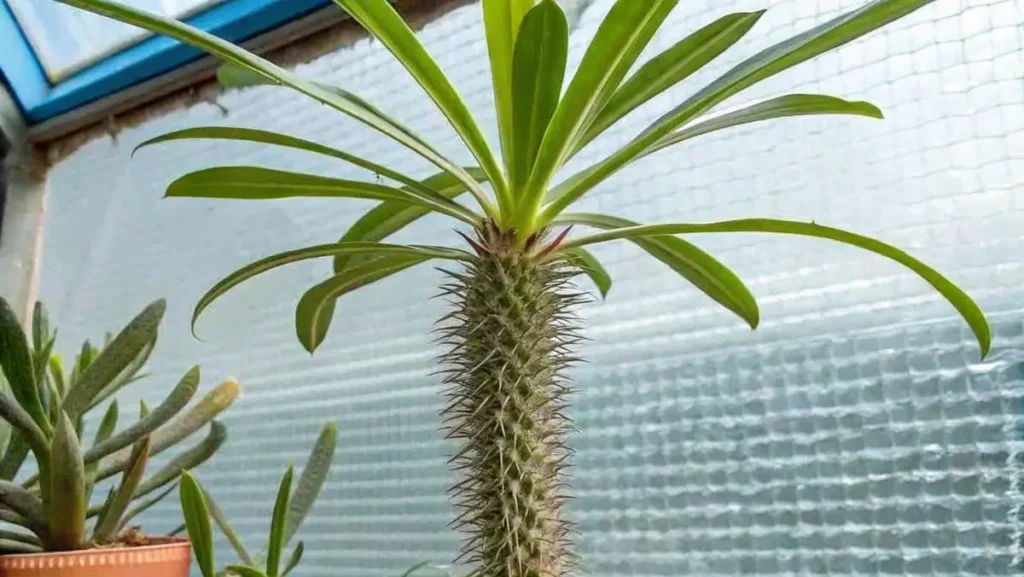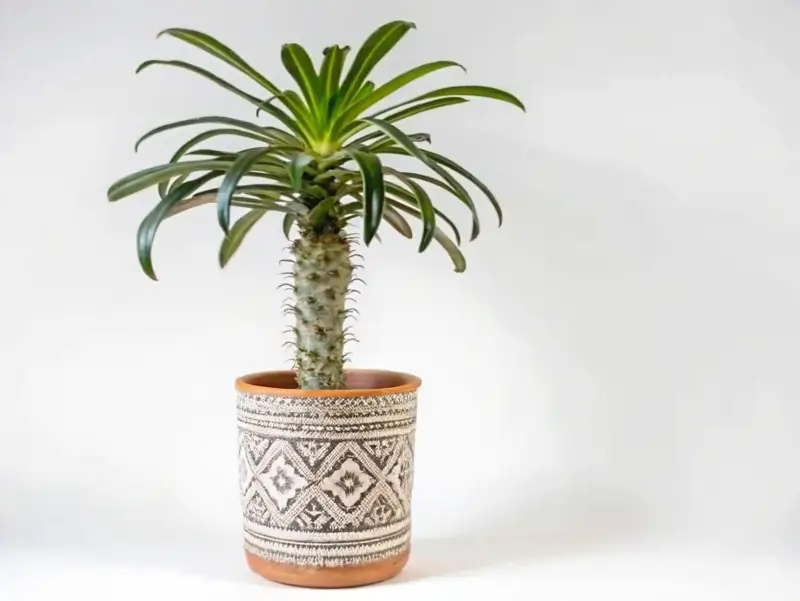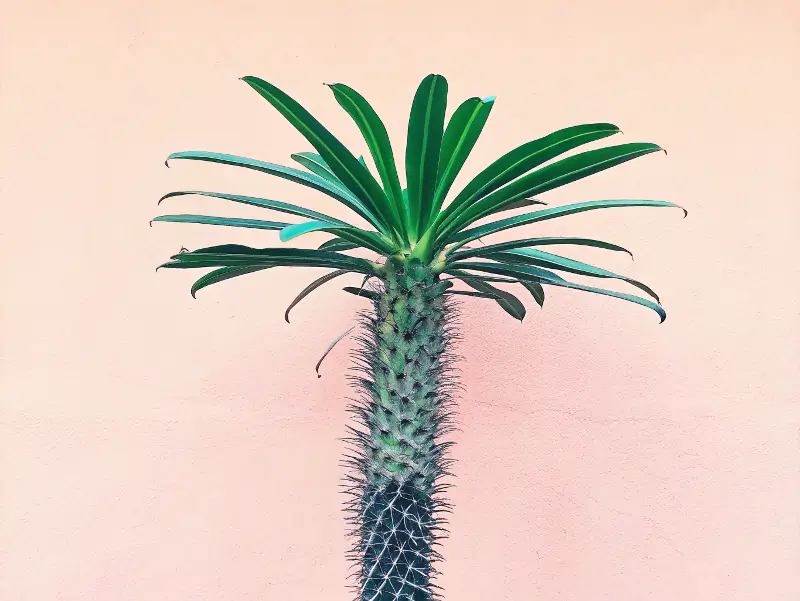
I’m stoked to chat about the madagascar palm plant and why it has quickly become one of my go-to favorites for a spiky, yet surprisingly chill houseguest. In this post, I’ll share personal tips, real-life experiences, and some down-to-earth know-how on growing and caring for your own madagascar palm plant. We’ll discuss how to keep it indoors, common hurdles, and how it always brings year-round joy—even with a busy routine.
Table of Contents
Introduction to the Madagascar Palm Plant
A Quick Overview of This Spiky Wonder
I remember the first time I saw a madagascar palm plant at a neighborhood nursery. At first glance, I thought, “Is it a cactus? A palm? Maybe an odd combo of both?” Turns out, it’s neither a straightforward cactus nor a true palm. Instead, it’s a unique succulent that many folks call a cactus palm plant due to its thick, spiny trunk and palm-like cluster of leaves up top.
- It’s originally from Madagascar, an island known for quirky flora and fauna.
- It stores water in its trunk to handle long dry spells.
- It looks like a miniature palm tree with a twist—tons of thorns!
While some might call it a madagascar palm, others say madagascar plant because of its origin. Whatever the name, this madagascar palm plant is a showstopper. I’ve had friends insist it looks like some sci-fi desert creature, especially when they accidentally poke themselves on the spines.
Surprising Popularity Among Indoor Gardeners
Though it appears exotic, the madagascar palm plant has become popular thanks to its minimal fuss factor. People dig how it blends a cactus-like vibe with the graceful look of a tropical palm. This playful mix genuinely brings a fresh flair to any houseplant collection—kind of like the one cousin who always rocks cowboy boots to a beach party.
Natural Habitat and Origin of the Madagascar Palm Plant
Where It All Began
The madagascar palm plant hails from—you guessed it—Madagascar. This island sits off the southeastern coast of Africa and features many dry regions. Over time, the plant developed water-storing abilities to handle scorching sunshine and limited rainfall. Frankly, if it can survive in those conditions, it’ll probably thrive on any sunny windowsill.
These traits explain why madagascar palm care calls for giving it plenty of bright light. It actually loves harsh sun, which might surprise people used to shadier houseplants. Also, because Madagascar’s climate can be pretty dry, the madagascar palm plant doesn’t mind low indoor humidity. That’s a big win for folks who blast the AC in summer or heat in winter.
Built for Tough Conditions
With a chunky trunk, the madagascar palm plant stores moisture like a champion, making it a lot like a cactus palm—sturdy on the outside, juicy on the inside. Thorns defend it from hungry critters that want a sip of its water.
If you’ve tried to re-position this plant, you’ve likely learned to handle it gently. I’ve definitely stabbed my hand a few times. All jokes aside, these spines are part of its natural armor, so it’s a surprisingly hardy buddy for your home.
Physical Characteristics and Growth Patterns

A Thorny Trunk and Leafy Crown
The madagascar palm plant has a trunk riddled with spines arranged in trios—some folks just call them “ouchy bits.” These spines can be quite sharp, so be careful when you rotate or dust off the trunk. Topping this trunk is a neat bouquet of long, narrow leaves, like a slim palm tree sporting a spiky hairstyle. I’ve had friends ask, “Is that some type of futuristic cactus palm plant?” Indeed, it’s that unique.
Seasonal Growth and Leaf Drop
- In spring or early summer, fresh leaves often pop in if the madagascar palm plant has enough sun.
- During winter, it might shed leaves if the house gets chilly at night.
- Mild leaf drop is normal, so don’t freak out.
Indoors, I’ve seen a madagascar palm plant shoot up to around 4 or 5 feet, but it can get taller with the right conditions. In the wild, though, these guys can soar over 15 feet! Still, inside your living room, it’ll remain more approachable. It’s the perfect conversation starter for plant-loving visitors who admire odd-looking greenery.
How to Grow a Madagascar Palm Plant at Home
Picking the Right Soil and Pot
- Use a coarse, quick-draining cactus mix.
- Pick a pot with proper drainage holes.
- Avoid going too large on the pot size to prohibit waterlogging.
Once, I over-potted my madagascar palm plant in a decorative pot with no drainage, and it nearly drowned. Thankfully, I noticed the soggy trunk in time to switch containers. Even though the madagascar palm plant is resilient, it doesn’t appreciate constant moisture.
Simple Propagation Options
Most people snag a nursery-grown edition of this madagascar palm plant, but you can start from seed if you’re feeling adventurous:
- Grab fresh seeds, bury them in a succulent-friendly mix, and keep them gently moist.
- Ensure the temperature remains around the mid-70s Fahrenheit.
- Give them moderate, indirect light until seedlings start sprouting.
You can attempt cuttings if you’re patient, but it’s trickier. Honestly, I prefer buying a baby madagascar plant already established. That’s a quick way to enjoy the rosette of leaves and spiky trunk without guessing whether seeds will pop.
Madagascar Palm Care Tips

Watering and Feeding—Keep It Sparse
Remember, treat your madagascar palm plant somewhat like a cactus. Overwatering is the cardinal sin. My approach:
- Let the top inch or two of soil dry before watering again.
- During cooler times, space out watering further.
- Light fertilizing in spring encourages fresh leaf growth.
I often remind myself, “A healthy madagascar palm plant trunk feels firm.” If it’s squishy, I’ve gone too heavy on the water. Fit this schedule around your climate, and keep a watchful eye for any droop that might suggest it’s too dry—or too wet!
Lighting and Temperature
- Aim for 6+ hours of direct sun daily if possible.
- A south- or west-facing window is usually awesome.
- Try to keep room temperature above 65°F.
I place my cactus palm by a bright window, and it rewards me with lush leaves. If you only have moderate light, it’ll survive but grow slower—like it’s waiting for a chance to burst into full glory. Warmer weather and strong light often spark new leaves, especially in late spring, so watch your madagascar palm plant come to life!
Common Problems and Troubleshooting
Pests That Might Pester
Even though the madagascar palm plant is tough, it can gather unwanted visitors:
- Spider mites
- Scale insects
- Mealybugs
I’ve had a spider mite invasion once, and it was super annoying. I used a mild soapy water spray, and that helped big time. Just be careful around the spines. Wiping each leaf can be a balancing act, and you don’t want a thorn in your thumb.
Signs of Overwatering
Root rot is the biggest villain in madagascar palm care. Watch for:
- A soft, mushy trunk
- Foul-smelling, blackened roots
- Drooping leaves despite moist soil
Rescue involves repotting in a well-draining mix and pruning out the rotten bits. Then, cross your fingers the plant rebounds. I’ve managed to save a madagascar palm plant after one soggy mistake, but it took a few months of nursing. Actually, this taught me the golden rule: smaller sips of water are better than big gulps.
Landscaping and Design Ideas for the Madagascar Palm Plant
Indoor Showcase
If you’re into exotic stuff, placing a madagascar palm plant in your living space can make it pop. I usually highlight mine with simpler foliage plants or succulents around it:
- Situate it near a plain background so the spines and trunk stand out.
- Group it among desert-themed plants for that cohesive aesthetic.
- Coordinate with a stylish pot that accentuates its silhouette.
Craving an overall palm look indoors? You might also like Potted Palm Trees for additional tropical flair. Pairing them with your madagascar palm plant can create a little indoor paradise scene, perfect for days when you wish you were on an island escape.
Outdoor Placement
In zones with warm, mild winters, feel free to let your cactus palm plant soak up natural sun on a porch or balcony. Just avoid freezing temperatures, because that can harm it. If you’re dealing with a small garden space, Small Palm Trees can round out the look. Position them strategically so your madagascar palm plant keeps full sun and doesn’t get overshadowed by bigger plants. It’s all about giving it the spotlight it deserves.
FAQs About the Madagascar Palm Plant
Do Madagascar Palms Like Sun or Shade?
Hands down, a madagascar palm plant craves sun. Low light may cause leaf drop and a lanky trunk. It’ll grow best if it gets its daily sunbath, but if you only have partial shade, it can adapt—just more slowly.
How Do You Handle Madagascar Palm Care?
Approach it like a succulent. Allow the soil to dry a bit, give it bright light, and fertilize lightly in spring. If you’ve been comfortable caring for cacti, madagascar palm care won’t feel extraordinary. The biggest difference is its palm-like leaves that can appear or fade depending on conditions.
Are the Thorns on a Madagascar Palm Hazardous?
They’re not famously toxic, but they pack a punch if you bump into them. I always advise gloves when repotting or rotating a madagascar palm plant. Better safe than sorry—there’s no fun in an unexpected poke!
How Tall Can a Madagascar Palm Plant Grow?
Indoors, you can see heights of 4–6 feet in time. It grows faster in toasty, well-lit rooms. Outside in Madagascar, though, a madagascar palm plant can surpass 15 feet, which is mind-boggling to imagine next to your sofa.
Conclusion and Final Thoughts
Reflecting on the Madagascar Palm Plant
To be honest, the madagascar palm plant expanded my perspective on desert-like houseplants. Its spiky trunk may look intimidating, but it’s incredibly low-maintenance. During the spring months, I love seeing it push out fresh leaves, signaling that it’s ready to soak up more sunshine. And during winter, it becomes a bit dormant, dropping a leaf or two, but springs back to life when warmth returns.
Some Final Pointers and Extra Resources
- Use a gritty potting mix. This madagascar palm plant hates soggy feet.
- Water sparingly—let it dry between drinks.
- Give it direct sunlight for at least a few hours daily.
- Feed it gently in spring, and watch it stand tall.
If you need climate-specific tips, the official USDA site can help you see your growing zone info. This ensures you know if it’s safe to place your madagascar palm plant outdoors. In my experience, though, no matter your region, it’s a breeze to keep it inside. With a bit of mindful watering and a sunny window, this madagascar palm plant will reward you with striking looks and a sense of the exotic—like having a miniature slice of Madagascar right in your living room.
